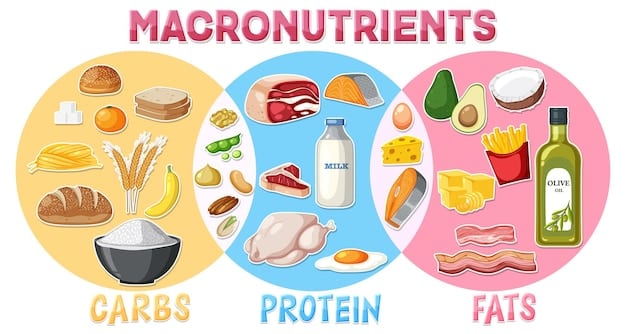Ultimate Bulking Nutrition Plan: Gain Muscle by 2025

The ultimate bulking nutrition plan for 2025 strategically optimizes caloric surplus with a precise macronutrient balance to foster muscle growth, aiming for a consistent 0.5-1 pound lean mass gain weekly through calculated dietary adjustments and consistent intake.
Embarking on a journey to significantly increase muscle mass requires more than just consistent effort in the gym; it demands a meticulous approach to nutrition. The pursuit of gaining 0.5-1 pound of quality muscle per week by 2025 necessitates a deep understanding and precise application of an effective ultimate bulking nutrition plan: gain 0.5-1 pound of muscle per week in 2025. This strategic dietary framework is the cornerstone of hypertrophy, providing the necessary fuel and building blocks for your body to synthesize new muscle tissue efficiently.
understanding the bulking imperative: more than just eating
Many equate “bulking” with simply eating more, often without regard for food quality or macronutrient distribution. This approach frequently leads to excessive fat gain rather than quality muscle. True bulking, especially when aiming for a precise rate of muscle gain like 0.5-1 pound per week, is an art and a science. It requires a deliberate caloric surplus, but one that is carefully managed to maximize muscle protein synthesis while minimizing adipose tissue accumulation. Understanding the ‘why’ behind each dietary choice is as crucial as the ‘what’.
The human body is an intricate machine, constantly adapting to the demands placed upon it. To build muscle, it needs an excess of energy beyond its daily expenditure, typically referred to as a caloric surplus. However, this surplus needs to be composed of the right types of fuel. Protein provides the amino acids essential for muscle repair and growth, carbohydrates fuel intense workouts and replenish glycogen stores, and healthy fats support hormone production and overall cellular function. Neglecting any of these components can compromise the bulking process, leading to suboptimal results or unwanted side effects.
metabolism and individual needs
Everyone’s metabolism is unique, influenced by genetics, activity level, body composition, and more. This individuality means there’s no one-size-fits-all bulking plan. What works for one person might lead to excessive fat gain for another, or insufficient muscle growth for a third. Therefore, the ultimate bulking nutrition plan for 2025 embraces personalization. It starts with calculating your basal metabolic rate (BMR) and total daily energy expenditure (TDEE), then adding a calculated surplus. This initial calculation serves as a baseline, which is then fine-tuned through consistent monitoring and adjustments.
- Caloric Surplus: A modest surplus of 250-500 calories above TDEE is generally recommended for lean bulking.
- Protein Intake: Aim for 1.6-2.2 grams of protein per kilogram of body weight to support muscle synthesis.
- Carbohydrate Strategy: Carbohydrates should comprise 45-60% of total calories, adjusted based on activity level.
- Healthy Fats: 20-30% of total calories from healthy fats are crucial for hormonal balance and overall health.
Beyond initial calculations, consistent monitoring of body composition, strength gains, and energy levels is paramount. If weight gain is too rapid and includes a significant increase in waist circumference, the caloric surplus might be too high. Conversely, if strength plateaus and weight gain is minimal, a slight increase in calories might be necessary. This iterative process of adjustment ensures the plan remains effective and aligned with the goal of lean muscle gain.
calculating your caloric needs for lean muscle gain
The foundation of any successful bulking plan is an accurate assessment of your caloric requirements. Without consuming enough calories, your body won’t have the energy to build new muscle tissue, regardless of how much protein you consume or how hard you train. Conversely, consuming too many calories can lead to excessive fat accumulation, negating the aesthetic and performance benefits of lean muscle gain. The goal is to find that sweet spot, the optimal caloric surplus. By 2025, advanced computational tools and wearable technology will further refine these calculations, but the core principles remain. It’s about precision.
Start by determining your Basal Metabolic Rate (BMR), which represents the calories your body burns at rest. While various formulas exist, the Mifflin-St Jeor equation is widely regarded as one of the most accurate. Once you have your BMR, multiply it by an activity factor to determine your Total Daily Energy Expenditure (TDEE). This TDEE is the number of calories your body burns in a day, accounting for all activities, from sleeping to intense workouts. This is your maintenance caloric intake.
the calculated surplus
To initiate muscle growth, you need to provide your body with more energy than it expends. This is your caloric surplus. For conservative, lean bulking, a surplus of 250 to 500 calories above your TDEE is generally recommended. This range aims to optimize muscle protein synthesis while minimizing the risk of excessive fat storage. A 250-calorie surplus theoretically leads to a weekly gain of approximately 0.5 pounds, while a 500-calorie surplus targets a 1-pound gain, aligning perfectly with our goal for 2025. This surplus isn’t fixed; it’s a starting point that requires ongoing assessment.
- BMR Calculation: Utilize formulas like Mifflin-St Jeor, considering age, sex, weight, and height.
- Activity Factor: Accurately assess your daily activity level (sedentary, lightly active, moderately active, very active, extremely active).
- Target Surplus: Add 250-500 calories to your TDEE for lean muscle gain.
While these calculations provide a strong starting point, constant monitoring is key. Track your weight weekly, paying attention to body composition changes. If you’re gaining more than 1 pound per week, and it appears to be mostly fat, reduce your caloric surplus by 100-200 calories per day. If you’re not gaining weight or seeing minimal progress, consider increasing your surplus by a similar amount. This iterative process, guided by data, will lead to the most effective and sustainable bulking strategy.

macronutrient mastery: precision fueling for muscle growth
Once your caloric target is established, the next critical step is to correctly apportion these calories among the three macronutrients: protein, carbohydrates, and fats. Each plays a distinct yet equally important role in muscle growth, recovery, and overall health. A haphazard approach to macros can undermine even the most perfectly calculated caloric surplus, leading to inefficient muscle gain or compromised performance. Achieving mastery over macronutrient distribution is a hallmark of an effective bulking nutrition plan.
Protein is arguably the most recognized macronutrient for muscle building, and for good reason. It provides the amino acids that act as the building blocks for new muscle tissue and repair damaged muscle fibers post-workout. Without adequate protein, muscle protein synthesis cannot occur optimally. However, protein alone is not enough. Carbohydrates are the body’s preferred energy source, fueling high-intensity workouts and replenishing glycogen stores, which are crucial for performance and recovery. Fats, often unfairly maligned, are vital for hormone production (including testosterone), nutrient absorption, and overall cellular integrity.
protein: the essential building block
For muscle growth, a general guideline is to consume 1.6 to 2.2 grams of protein per kilogram of body weight. For a person weighing 80 kg (approximately 176 lbs), this translates to 128-176 grams of protein per day. Focus on high-quality, complete protein sources that provide all essential amino acids. Distribute your protein intake throughout the day, aiming for 20-40 grams per meal to optimize muscle protein synthesis. Pre- and post-workout protein intake is particularly beneficial for recovery and growth.
- Lean Meats: Chicken breast, turkey, lean beef, fish.
- Dairy: Greek yogurt, cottage cheese, milk.
- Eggs: Whole eggs are excellent sources of complete protein.
- Plant-Based: Tofu, tempeh, lentils, beans, quinoa (in combination).
carbohydrates: the power fuel
Carbohydrates should constitute the largest portion of your caloric intake during bulking, typically ranging from 45% to 60% of total calories. These are your primary energy source for intense training and help spare protein for muscle building. Prioritize complex carbohydrates for sustained energy release and fiber content, which aids digestion and satiety. Simple carbohydrates can be utilized strategically around workouts for quick energy and glycogen replenishment.
- Complex Carbs: Oats, brown rice, quinoa, whole-wheat bread, sweet potatoes.
- Starchy Vegetables: Potatoes, corn, peas.
- Fruits: Berries, bananas, apples for vitamins, minerals, and natural sugars.
healthy fats: the unsung heroes
Fats should make up 20% to 30% of your total daily calories. Don’t shy away from healthy fats; they are crucial for hormone production, nutrient absorption, and maintaining overall health. A deficiency in healthy fats can impair testosterone production, which is vital for muscle growth. Prioritize unsaturated fats, and include some saturated fat in moderation.
- Monounsaturated Fats: Avocados, olive oil, nuts (almonds, cashews).
- Polyunsaturated Fats: Fatty fish (salmon, mackerel), walnuts, flaxseeds, chia seeds.
- Saturated Fats: Found in red meat, dairy (in moderation).
By meticulously tracking and adjusting your macronutrient intake, you provide your body with the precise fuel it needs for optimal muscle growth. This calculated approach ensures that every calorie contributes effectively to your bulking goals, moving you closer to gaining 0.5-1 pound of muscle per week in 2025.
meal timing and frequency: optimizing nutrient delivery
Beyond what you eat, when and how often you eat can significantly impact the effectiveness of your bulking plan. Strategic meal timing and frequency aim to optimize nutrient delivery, maintain a positive nitrogen balance (essential for muscle growth), and support consistent energy levels throughout the day. While the “anabolic window” concept has evolved, the general principle of regular nutrient intake to fuel and recover from training remains crucial. By 2025, personalized meal schedules based on individual circadian rhythms and training protocols will likely become even more refined.
Eating every few hours, typically 5-6 meals a day, helps ensure a steady supply of amino acids to your muscles, preventing catabolism (muscle breakdown) and promoting continuous muscle protein synthesis. This frequent feeding strategy also helps manage the large caloric and macronutrient load required for bulking, making it easier to consume the necessary quantities without feeling overly full or uncomfortable. Each meal should be balanced, containing all three macronutrients to support sustained energy and muscle anabolism.
pre- and post-workout nutrition
The peri-workout period (around your training session) is particularly important for maximizing performance and recovery. A pre-workout meal, consumed 1-2 hours before training, should provide complex carbohydrates for sustained energy and a moderate amount of protein to prepare muscles for activity. Post-workout nutrition is critical for initiating the repair and recovery process. Consuming a meal rich in fast-digesting carbohydrates and protein immediately after your workout helps replenish glycogen stores and kick-starts muscle protein synthesis.
- Pre-Workout: Oatmeal with a scoop of whey protein, a banana, and a handful of nuts.
- Post-Workout: Rice and chicken, a protein shake with dextrose/maltodextrin, or a sweet potato and lean fish.
Even on rest days, maintaining consistent meal timing and frequency is important. Your muscles aren’t just growing during your workouts; they’re repairing and growing during rest periods, provided they receive continuous nutrient support. Adhering to a structured eating schedule helps maintain the caloric surplus and nutrient balance necessary for ongoing anabolism. It also trains your body to expect regular nourishment, optimizing its metabolic response.
While the exact timing can be flexible to fit individual schedules, the consistency of consuming nutrient-dense meals throughout the day is what truly matters. This sustained nutrient flow contributes significantly to achieving the weekly muscle gain targets, making strategic meal timing an indispensable component of the ultimate bulking nutrition plan.
hydration and micronutrients: often overlooked, always essential
In the pursuit of muscle growth, the focus often heavily gravitates towards protein, carbs, and fats. However, two critical components that are frequently overlooked, yet profoundly impact performance, recovery, and overall health in a bulking phase, are hydration and micronutrients. Adequate water intake and a robust supply of vitamins and minerals are not accessories; they are non-negotiable foundations for optimal physiological function, directly influencing everything from energy production to muscle contraction and nutrient absorption. Neglecting these aspects can severely impede your progress towards gaining 0.5-1 pound of muscle per week.
Water constitutes a significant portion of our muscle mass and is involved in countless biological processes, including nutrient transport, waste removal, and temperature regulation. Even slight dehydration can lead to a decrease in strength, endurance, and mental focus, hindering workout performance and recovery. During bulking, with increased caloric intake and intense training, your body’s demand for water escalates. Similarly, micronutrients—vitamins and minerals—act as cofactors for numerous enzymatic reactions vital for energy metabolism, protein synthesis, and immune function. They ensure that the macros you consume are effectively utilized.
hydration: the silent performance enhancer
For individuals engaged in intense strength training and consuming a higher caloric intake, the general recommendation of eight glasses of water per day is often insufficient. A more appropriate guideline is to aim for at least 3-4 liters (100-135 fl oz) of water daily, adjusted based on activity level, climate, and individual sweat rates. Pay attention to your urine color; light yellow indicates good hydration, while dark yellow suggests dehydration.
- Before Workout: 500-600 ml (17-20 fl oz) of water 2-3 hours prior.
- During Workout: 200-300 ml (7-10 fl oz) every 15-20 minutes.
- After Workout: 1.5 times the fluid weight lost during exercise.
- Throughout the Day: Consistently sip water, not just when thirsty.
micronutrients: the catalysts for growth
While a varied diet rich in whole foods should typically provide a broad spectrum of micronutrients, the increased demands of bulking sometimes necessitate additional attention to sufficient intake. Focus on consuming a wide variety of fruits, vegetables, whole grains, and legumes to ensure you’re getting a complete profile of vitamins and minerals. Key micronutrients for muscle growth and performance include B vitamins (for energy metabolism), Vitamin D (for hormone health and bone density), calcium (for muscle function), iron (for oxygen transport), magnesium (for muscle relaxation and energy production), and zinc (for testosterone production and immune function).
Consider supplementing with a high-quality multivitamin if you suspect dietary gaps. However, remember that supplements are just that—supplements. They complement a solid diet, they don’t replace it. Prioritize nutrient-dense whole foods to optimize your micronutrient status, ensuring your body has all the tools it needs to effectively build muscle and recover, staying on track for your 2025 goals. This holistic approach underpins the ultimate bulking nutrition plan, allowing your body to function at its peak and transform effectively.

supplements: enhancing, not replacing, a solid diet
The supplement industry is vast and often bewildering, promising quick fixes and miraculous gains. However, for an effective bulking nutrition plan aimed at gaining 0.5-1 pound of muscle per week, supplements should be viewed as exactly that: supplements. They are designed to complement and enhance a meticulously planned whole-food diet, filling nutritional gaps or providing an ergogenic edge, never to replace foundational nutrition. By 2025, the scientific understanding of effective supplementation will likely continue to refine, favoring evidence-based choices over marketing hype.
The core principle remains: prioritize real food first. A well-constructed diet should provide the vast majority of your caloric and macronutrient needs, alongside essential vitamins and minerals. Once this foundation is solid, strategic supplementation can offer additional benefits for muscle growth, recovery, and overall performance. It’s about making informed choices based on scientific evidence and individual needs, rather than chasing every new product on the market.
evidence-based supplements for bulking
Several supplements have a strong body of scientific evidence supporting their efficacy for muscle growth and performance. Recognizing these key players can help you navigate the crowded market and invest wisely in products that genuinely offer benefits to your bulking journey. These are not magic pills but rather tools to optimize your physiological processes.
- Whey Protein: A fast-digesting protein source, ideal for post-workout recovery and hitting daily protein targets.
- Creatine Monohydrate: Enhances strength and power output, increases muscle cell hydration, and supports ATP regeneration.
- Beta-Alanine: Boosts muscle carnosine levels, buffering lactic acid and improving endurance during high-intensity exercise.
- BCAAs (Branched-Chain Amino Acids): May help reduce muscle soreness and promote recovery, especially useful during caloric deficits or high training volumes.
- Fish Oil (Omega-3s): Supports overall health, reduces inflammation, and may aid muscle recovery.
- Multivitamin: Acts as an insurance policy to cover any potential micronutrient deficiencies from the diet.
Before incorporating any supplement, it’s advisable to consult with a healthcare professional or a registered dietitian, especially if you have underlying health conditions. Furthermore, always source supplements from reputable brands to ensure product quality and purity. Remember, the ultimate bulking nutrition plan is built on consistent, high-quality food intake, with supplements acting as supportive players, helping you achieve your 0.5-1 pound muscle gain target by 2025.
monitoring progress and making adjustments
The journey of a successful bulking phase is rarely a linear one. What works perfectly in the initial weeks may need refinement as your body adapts and its needs change. Therefore, an essential, yet often overlooked, component of the ultimate bulking nutrition plan is consistent monitoring of progress and the willingness to make timely adjustments. This iterative process, driven by objective data and subjective feedback from your body, ensures that you stay on track towards gaining 0.5-1 pound of quality muscle per week in 2025, rather than veering off into excessive fat gain or stagnation.
Effective monitoring goes beyond just stepping on a scale. It involves a holistic assessment of various indicators that collectively paint a clear picture of your progress. Relying solely on weight can be misleading, as fluctuations can be due to water retention, glycogen storage, or fat gain, not just lean muscle. Integrating multiple metrics provides a more accurate and actionable understanding of how your body is responding to the nutritional and training stimulus.
key metrics to track
To accurately assess your progress, employ a multi-faceted approach to tracking. Consistency in measuring these metrics is more important than the specific day or time, as long as it’s consistent. For instance, weighing yourself at the same time each morning after using the restroom provides a more reliable baseline.
- Body Weight: Weigh yourself 2-3 times per week, first thing in the morning, and calculate a weekly average to smooth out daily fluctuations. Aim for a 0.5-1 pound increase per week.
- Body Composition: Track waist circumference, hip circumference, and preferred areas (e.g., biceps, thighs) monthly. Visual assessment in the mirror and progress photos can also be helpful.
- Strength Progression: Log your workouts and strive for progressive overload. Increasing strength in compound lifts is a strong indicator of muscle gain.
- Energy Levels and Recovery: Pay attention to how you feel. Are you energized during workouts? Recovering well between sessions? Consistent fatigue or inability to recover might indicate insufficient calories or poor sleep.
- Appetite and Satiety: Are you consistently hungry, suggesting you might need more calories, or feeling overly full, indicating too high of a surplus?
Based on the data collected, be prepared to adjust your caloric intake and/or macronutrient ratios. If weekly weight gain is significantly greater than 1 pound and is accompanied by an increasing waistline, consider reducing your daily caloric surplus by 100-200 calories. If weight gain is stagnant and strength plateaus, a 100-200 calorie increase might be necessary. This responsiveness to your body’s signals is what transforms a generic plan into a personalized, highly effective bulking strategy, ensuring you continually optimize for consistent muscle gain.
| Key Point | Brief Description |
|---|---|
| 💪 Caloric Surplus | Target 250-500 calories above TDEE for lean gain. |
| 🥩 Macronutrient Focus | Optimal protein (1.6-2.2g/kg), carbs (45-60%), fats (20-30%). |
| ⏰ Meal Timing | Frequent, balanced meals with proper pre/post-workout nutrition. |
| 💧 Hydration & Micros | Crucial for performance, recovery, and overall health. |
frequently asked questions (FAQ)
▼
For lean bulking, a caloric surplus of 250-500 calories above your Total Daily Energy Expenditure (TDEE) is generally recommended. This range aims to support muscle growth efficiently while minimizing the accumulation of excess body fat. Starting at the lower end and adjusting based on weekly progress is often the most effective strategy.
▼
Aim for 1.6 to 2.2 grams of protein per kilogram of body weight daily. This ensures an adequate supply of amino acids for muscle repair and synthesis. Distribute your protein intake evenly across your meals throughout the day to maximize absorption and muscle protein synthesis responses.
▼
While a solid, consistent whole-food diet is the foundation of muscle gain, certain supplements can enhance the process. Whey protein, creatine monohydrate, and possibly a multivitamin are among the most scientifically-backed options to support training performance, recovery, and nutrient intake during a bulking phase. They are complementary, not essential replacements.
▼
Monitor your progress weekly by tracking body weight, body measurements, and strength gains. If your weight gain is consistently outside the 0.5-1 pound per week target, or if body composition changes are unfavorable, consider adjusting your caloric intake by 100-200 calories. Adjustments should be gradual and data-driven.
▼
Carbohydrates are the body’s primary energy source, crucial for fueling intense workouts and replenishing muscle glycogen stores. They also help spare protein for muscle building rather than energy. Aim for 45-60% of your total calories from carbohydrates, prioritizing complex sources for sustained energy and fiber for digestive health during your bulk.
conclusion
The pursuit of building 0.5-1 pound of quality muscle per week by 2025 is an ambitious yet achievable goal, fundamentally rooted in a precise and adaptable nutrition strategy. The ultimate bulking nutrition plan isn’t a rigid blueprint but a dynamic framework emphasizing a calculated caloric surplus, meticulous macronutrient balance, strategic meal timing, and unwavering attention to hydration and micronutrients. It prioritizes real, nutrient-dense foods as the foundation, with evidence-based supplements playing a supportive role. Crucially, success hinges on consistent monitoring and a willingness to make iterative adjustments based on your body’s unique response. By adopting this comprehensive and intelligent approach, you can systematically fuel your body for optimal muscle growth, transforming your physique effectively and sustainably. This journey demands discipline, but the rewards of a stronger, more muscular you are well within reach.





